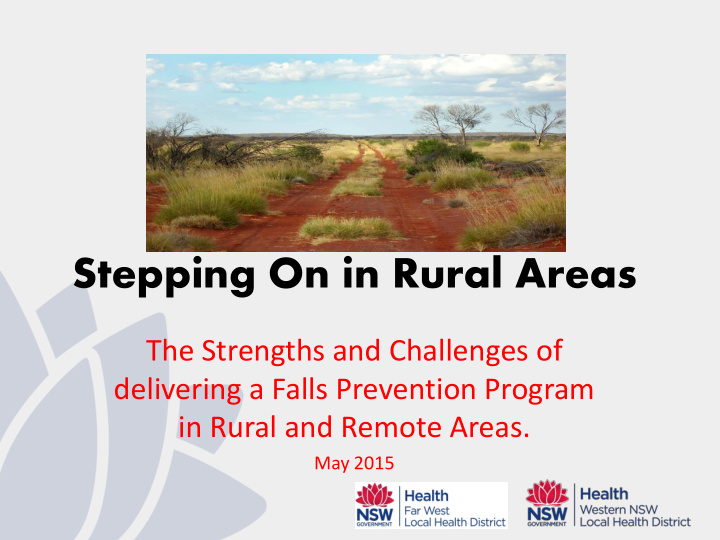



Stepping On in Rural Areas The Strengths and Challenges of delivering a Falls Prevention Program in Rural and Remote Areas. May 2015
Recognition We respect and acknowledge the Past, Present and Future aboriginal people on who's traditional land we work, live and learn in. We acknowledge the Gadigal of the Eora nation and the Wiradjuri people.
Introduction Cheryl Uptin • Physiotherapy Assistant, Parkes, NSW. • Enrolled Nurse and with an Aged Care background. • ‘Stepping On” facilitator since 2013 in Parkes. Conducts 3 – 4 programs/year Julie Morgan • Physiotherapy Assistant, Forbes, NSW. • ‘Stepping On” facilitator, Forbes • Occupational Therapy Assistant at Royal Hobart Hospital • Conducted Falls Education over 6 years, Rehab Wards
Outline • Overview of Stepping On Program. • Advantages and Disadvantages of working in Rural Areas. • How we have overcome the problems. • Summary • References
Far West and Western LHDs Our combined total area is 444,949km2 This is equivalent to size of Germany! Both LHDs are diverse and sparsely populated ranging from 80 to over 40000
General Health • Isolation. • Working And living in small communities. • Poorer health in remote and rural areas than metropolitan. • Doesn’t like to admit ageing and unable to do things. • Doesn’t like going to Dr’s. ‘She’ll be right mate!’ • Occupational hearing loss, poor eyesight, poor memory, poor balance on uneven terrain and farming equipment.
‘Stepping On’ in Far West & Western LHDs
Our Communities - Parkes and Forbes • Approx. Population of Parkes - 14,592 Forbes - 9,818 • Approx. Aboriginal population of Parkes - 637 • Forbes - 883 • In NSW 1 in 4 people who present to emergency have had a falls. Falls that presented to our Hospitals were 52 in 2015 • We delivered 2 ‘Stepping On’ Programs in our area last year with 2 currently being run at present.
Challenges of Running a Stepping On Program in Rural and Remote Areas For Facilitators • Access to Health Professionals • Planning Considerations – Weather and Road Conditions; Seasonal; Workloads; Distance to satellite communities; • Numbers – numbers to draw on
Challenges of Running a Stepping On Program in Rural and Remote Areas For Participants • Time and affordability when living in outlying areas. • Transport and distance to travel. • Weather and road conditions. • Organising around a small town.
Strengths of Running a Stepping On Program in Rural and Remote Areas • Prolonging independence at home. • Multi Disciplinary Team approach. • Building Networks between participants. • Tailored groups to suit individuals
Our Final Thoughts Our area is made up of diverse communities. We tailor our groups to target our participants and their environments. Our advantages are knowing our communities from a professional point of view as well as a personal one. We strive to prolong independence at home.
“Stepping On” is fun!
References • Health in Rural and Remote Australia – The first report of the Australian Institute of Health and Welfare on rural health, Strong, Trickett, Titulaer, Bhatia. • Preventing Falls for older Farmers – The Australian Centre for Agricultural Health and Safety , University of Sydney. • National Falls Prevention for Older People Plan – 2004 Onwards, July 2005 • Stepping On Program – Clemson and Swann • Farm Health and Safety Toolkit for Rural General Practices – The Australian Centre for Agricultural Health and Safety, University of Sydney
Recommend
More recommend